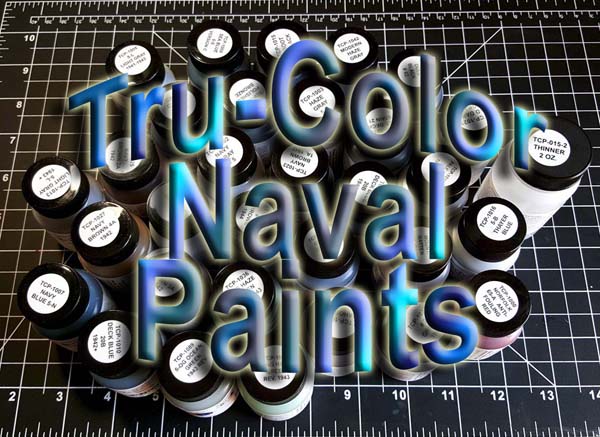The review samples:
When asked if Iíd like to review these paints, I said definitely, and
expected a half-dozen bottles to sample. Imagine my surprise when I received
a box with 32 bottles of paint and 1 of thinner! Hereís what was in that
box:
What they are:
Tru-Color paints are a somewhat solvent based acrylic. They remind
me a lot of Tamiya paints, but instead of being alcohol based, the solvent
is in the realm of acetone. The proprietary thinner smells exactly like
nail polish remover. |
 |
Thinner
Navy Brown 1A
Navy Brown 2A
Navy Brown 4A
#4 Brown 1944
Navy Brown 3A, 1942
Ocean Gray 5-O Late 1941
Haze Gray 5-H
Boot Black |
Cavite Blue
Navy Blue 5-N
Polished Bronze
White 5-U
Deck Blue 20B
#2 Green 1944
Modern Haze Gray
Mahogany
Sea Blue 5-S Version C |
Light Gray 5-L, 1943+
Light Gray 5-L, 1941-1943
Navy Gray #5
5-HG Haze Green, Early 1943
Deck Blue 20B, 1942+
5-OG Ocean Green, 1943 Rev.
5-HG Haze Green, 1043 Rev.
Mount-Batten Pink (Dark) |
5-B Thayer Blue
5-D Dark Gray
Norfolk 65-A Anti-Fouling Red
Dull Black #82
Pale Gray 5-P, 1943+
Flight Deck Stain 21
5-O Ocean Gray, Early 1941 |
How they perform:
For my test, I sprayed several samples with a Grex airbrush, shooting
around 30psi. One sample sheet was on unprimed white styrene, for the other
set I used styrene primed with Badgerís Stynylrez acrylic primer.
The manufacturer states these can be sprayed straight out of the bottle
with no thinning. While thatís true, and the coverage is excellent with
that method, I did have an issue with in-air drying and the resulting rough/pebbly
texture that produces. Thinning slightly with the included thinner, though,
resolved that problem nicely, and gave a little translucence to the paint.
Iíd personally rather have my paint a little translucent, to allow for
better control of pre-shading and other weathering techniques.
One other test I did was to thin the Mahogany paint with Mr. Colorís
Self Leveling thinner, a lacquer thinner with drying retarder. This worked
a little too well. The paint went on extremely thin and smooth, but it
took a good 15 minutes for it to dry, as opposed to a minute or two with
the proprietary thinner. Not sure Iíd recommend using that for every paint
job, but if youíre going to use a small airbrush to paint a 1/200 scale
hull and want to up the dry time to minimize dry-edge banding, itís something
to keep in mind.
Brush painting works, but itís much like brush painting Tamiya paints.
They go on thin and skin very fast, so coverage must be accomplished in
layers. Put down a layer, wait a few minutes, put down the next. Full coverage
is achieved in 3 layers.
The manufacturer recommends cleaning your airbrush with straight acetone,
which I tested and it worked just fine. I, however, have an adverse reaction
to most concentrations of acetone Ė it gives me extremely dry skin -- and
Iíd much rather use lacquer thinner. I tested with generic lacquer thinner
from the hardware store and clean-up was quite easy.
How they match: |
NOTE: These are photos youíre looking at on a computer
screen. They are not going to look like what you get on a model. I have
a color corrected setup that I work with, and theyíre still not exactly
right. With the samples you see on the thin strips of styrene (5-H, 5-O,
5-P) I did those by dipping the styrene into the paint, resulting in a
slightly glossy, and thus darker, example. The matches are much closer
than youíre seeing in the photos. Like I said, photos are tricky.
I tested eight different Snyder and Short color chips against their
corresponding paints, five of them airbrushed on both unprimed white and
primed gray sheets; the other three samples were dipped in the paint bottles
just to quickly confirm they match the S&S samples. Overall the colors
are either spot-on, or close enough that youíll never tell the difference
unless you have the S&S color chip right next to an unweathered model.
Colors and hues match really well, and spraying them thinned, you can really
vary the coverage and allow the base colors to show through. The sprayed
white styrene samples came through a bit light, the gray a bit dark. The
Badger gray primer is a dark gray, so if you use something like Mr. Surfacerís
gray primer, or any other primer thatís close to the same shade as
#5 Navy Gray, as most primers are, youíll get a perfect, or nearly so,
match on most of the S&S paint chips. The 5-O for early 1941 is a little
light, and the 5-H Haze Gray is missing just a little bit of purple, but
those are minor quibbles. The only color that is off to any significant
degree is the Flight Deck Stain 21. The S&S sample has a definite blue
hue that the paint lacks; the paint is actually closer to the Norfolk 250N
on the S&S sample sheet, but is still too much in the dead-black range
and lacking the minimal blue that 250N shows. |

